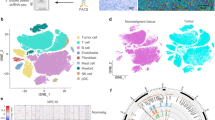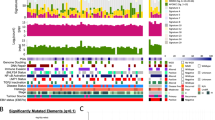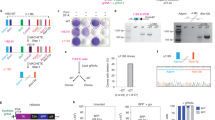Abstract
16q24 is frequently deleted in multiple tumors including cancers of nasopharynx, esophagus, breast, prostate and liver. By array comparative genomic hybridization (aCGH), we refined a 16q24 hemizygous deletion in nasopharyngeal carcinoma (NPC) cell lines. Semi-quantitative RT–PCR analysis revealed interferon regulatory factor 8 (IRF8) as the only downregulated gene within this deletion. IRF8 belongs to a family of interferon (IFN) regulatory factors that modulate various important physiologic processes including host defense, cell growth and differentiation and immune regulation. In contrast to the broad expression of IRF8 in normal adult and fetal tissues, transcriptional silencing and promoter methylation of IRF8 were frequently detected in multiple carcinoma (except for hepatocellular) cell lines (100% in NPC, 88% in esophageal and 18–78% in other carcinoma cell lines) and in a large collection of primary carcinomas (78% in NPC, 36–71% in other carcinomas). Methylation of the IRF8 promoter led to the disruption of its response to IFN-γ stimulation. Pharmacological and genetic demethylation could restore IRF8 expression, indicating a direct epigenetic mechanism. Ectopic expression of IRF8 in tumor cells lacking its expression strongly inhibited their clonogenicity, confirming its tumor suppressor function. Thus, IRF8 was identified as a functional tumor suppressor, which is frequently silenced by epigenetic mechanism in multiple carcinomas.
This is a preview of subscription content, access via your institution
Access options
Subscribe to this journal
Receive 50 print issues and online access
$259.00 per year
only $5.18 per issue
Buy this article
- Purchase on Springer Link
- Instant access to full article PDF
Prices may be subject to local taxes which are calculated during checkout






Similar content being viewed by others
References
Baylin SB, Ohm JE . (2006). Epigenetic gene silencing in cancer—a mechanism for early oncogenic pathway addiction? Nat Rev Cancer 6: 107–116.
Bouker KB, Skaar TC, Riggins RB, Harburger DS, Fernandez DR, Zwart A et al. (2005). Interferon regulatory factor-1 (IRF-1) exhibits tumor suppressor activities in breast cancer associated with caspase activation and induction of apoptosis. Carcinogenesis 26: 1527–1535.
Burchert A, Cai D, Hofbauer LC, Samuelsson MK, Slater EP, Duyster J et al. (2004). Interferon consensus sequence binding protein (ICSBP; IRF-8) antagonizes BCR/ABL and down-regulates bcl-2. Blood 103: 3480–3489.
Busson P, Ganem G, Flores P, Mugneret F, Clausse B, Caillou B et al. (1988). Establishment and characterization of three transplantable EBV-containing nasopharyngeal carcinomas. Int J Cancer 42: 599–606.
Chang HW, Chan A, Kwong DL, Wei WI, Sham JS, Yuen AP . (2003). Evaluation of hypermethylated tumor suppressor genes as tumor markers in mouth and throat rinsing fluid, nasopharyngeal swab and peripheral blood of nasopharygeal carcinoma patient. Int J Cancer 105: 851–855.
Chen YJ, Ko JY, Chen PJ, Shu CH, Hsu MT, Tsai SF et al. (1999). Chromosomal aberrations in nasopharyngeal carcinoma analyzed by comparative genomic hybridization. Genes Chromosomes Cancer 25: 169–175.
Egwuagu CE, Li W, Yu CR, Che Mei LM, Chan CC, Nakamura T et al. (2006). Interferon-gamma induces regression of epithelial cell carcinoma: critical roles of IRF-1 and ICSBP transcription factors. Oncogene 25: 3670–3679.
Hashmueli S, Gleit-Kielmanowicz M, Meraro D, Azriel A, Melamed D, Levi BZ . (2003). A truncated IFN-regulatory factor-8IFN consensus sequence-binding protein acts as dominant-negative, interferes with endogenous protein–protein interactions and leads to apoptosis of immune cells. Int Immunol 15: 807–815.
Holtschke T, Lohler J, Kanno Y, Fehr T, Giese N, Rosenbauer F et al. (1996). Immunodeficiency and chronic myelogenous leukemia-like syndrome in mice with a targeted mutation of the ICSBP gene. Cell 87: 307–317.
Hu G, Mancl ME, Barnes BJ . (2005). Signaling through IFN regulatory factor-5 sensitizes p53-deficient tumors to DNA damage-induced apoptosis and cell death. Cancer Res 65: 7403–7412.
Jin H, Wang X, Ying J, Wong AH, Cui Y, Srivastava G et al. (2007a). Epigenetic silencing of a Ca(2+)-regulated Ras GTPase-activating protein RASAL defines a new mechanism of Ras activation in human cancers. Proc Natl Acad Sci USA 104: 12353–12358.
Jin H, Wang X, Ying J, Wong AH, Li H, Lee KY et al. (2007b). Epigenetic identification of ADAMTS18 as a novel 16q23.1 tumor suppressor frequently silenced in esophageal, nasopharyngeal and multiple other carcinomas. Oncogene 26: 7490–7498.
Jones PA, Baylin SB . (2002). The fundamental role of epigenetic events in cancer. Nat Rev Genet 3: 415–428.
Kanno Y, Levi BZ, Tamura T, Ozato K . (2005). Immune cell-specific amplification of interferon signaling by the IRF-4/8-PU.1 complex. J Interferon Cytokine Res 25: 770–779.
Knudson AG . (2001). Two genetic hits (more or less) to cancer. Nat Rev Cancer 1: 157–162.
Lo KW, Kwong J, Hui AB, Chan SY, To KF, Chan AS et al. (2001). High frequency of promoter hypermethylation of RASSF1A in nasopharyngeal carcinoma. Cancer Res 61: 3877–3881.
Lo KW, Teo PM, Hui AB, To KF, Tsang YS, Chan SY et al. (2000). High resolution allelotype of microdissected primary nasopharyngeal carcinoma. Cancer Res 60: 3348–3353.
Lo KW, To KF, Huang DP . (2004). Focus on nasopharyngeal carcinoma. Cancer Cell 5: 423–428.
Lung HL, Bangarusamy DK, Xie D, Cheung AK, Cheng Y, Kumaran MK et al. (2005). THY1 is a candidate tumour suppressor gene with decreased expression in metastatic nasopharyngeal carcinoma. Oncogene 24: 6525–6532.
Lung HL, Cheung AK, Xie D, Cheng Y, Kwong FM, Murakami Y et al. (2006). TSLC1 is a tumor suppressor gene associated with metastasis in nasopharyngeal carcinoma. Cancer Res 66: 9385–9392.
Nguyen H, Hiscott J, Pitha PM . (1997). The growing family of interferon regulatory factors. Cytokine Growth Factor Rev 8: 293–312.
Paige AJ, Taylor KJ, Stewart A, Sgouros JG, Gabra H, Sellar GC et al. (2000). A 700-kb physical map of a region of 16q23.2 homozygously deleted in multiple cancers and spanning the common fragile site FRA16D. Cancer Res 60: 1690–1697.
Qiu GH, Tan LK, Loh KS, Lim CY, Srivastava G, Tsai ST et al. (2004). The candidate tumor suppressor gene BLU, located at the commonly deleted region 3p21.3, is an E2F-regulated, stress-responsive gene and inactivated by both epigenetic and genetic mechanisms in nasopharyngeal carcinoma. Oncogene 23: 4793–4806.
Rhee I, Bachman KE, Park BH, Jair KW, Yen RW, Schuebel KE et al. (2002). DNMT1 and DNMT3b cooperate to silence genes in human cancer cells. Nature 416: 552–556.
Schmidt M, Bies J, Tamura T, Ozato K, Wolff L . (2004). The interferon regulatory factor ICSBP/IRF-8 in combination with PU.1 up-regulates expression of tumor suppressor p15(Ink4b) in murine myeloid cells. Blood 103: 4142–4149.
Schmidt M, Nagel S, Proba J, Thiede C, Ritter M, Waring JF et al. (1998). Lack of interferon consensus sequence binding protein (ICSBP) transcripts in human myeloid leukemias. Blood 91: 22–29.
Srivastava G, Wong KY, Chiang AK, Lam KY, Tao Q . (2000). Coinfection of multiple strains of Epstein–Barr virus in immunocompetent normal individuals: reassessment of the viral carrier state. Blood 95: 2443–2445.
Steenbergen RD, Kramer D, Braakhuis BJ, Stern PL, Verheijen RH, Meijer CJ et al. (2004). TSLC1 gene silencing in cervical cancer cell lines and cervical neoplasia. J Natl Cancer Inst 96: 294–305.
Sun D, Zhang Z, Van dN, Huang G, Ernberg I, Hu L . (2007). Aberrant methylation of CDH13 gene in nasopharyngeal carcinoma could serve as a potential diagnostic biomarker. Oral Oncol 43: 82–87.
Tamura T, Kong HJ, Tunyaplin C, Tsujimura H, Calame K, Ozato K . (2003). ICSBP/IRF-8 inhibits mitogenic activity of p210 Bcr/Abl in differentiating myeloid progenitor cells. Blood 102: 4547–4554.
Tamura T, Ozato K . (2002). ICSBP/IRF-8: its regulatory roles in the development of myeloid cells. J Interferon Cytokine Res 22: 145–152.
Tamura T, Thotakura P, Tanaka TS, Ko MS, Ozato K . (2005). Identification of target genes and a unique cis element regulated by IRF-8 in developing macrophages. Blood 106: 1938–1947.
Tao Q, Chan AT . (2007). Nasopharyngeal carcinoma: molecular pathogenesis and therapeutic developments. Expert Rev Mol Med 9: 1–24.
Tao Q, Huang H, Geiman TM, Lim CY, Fu L, Qiu GH et al. (2002). Defective de novo methylation of viral and cellular DNA sequences in ICF syndrome cells. Hum Mol Genet 11: 2091–2102.
Toyooka KO, Toyooka S, Virmani AK, Sathyanarayana UG, Euhus DM, Gilcrease M et al. (2001). Loss of expression and aberrant methylation of the CDH13 (H-cadherin) gene in breast and lung carcinomas. Cancer Res 61: 4556–4560.
Tsao SW, Wang X, Liu Y, Cheung YC, Feng H, Zheng Z et al. (2002). Establishment of two immortalized nasopharyngeal epithelial cell lines using SV40 large T and HPV16E6/E7 viral oncogenes. Biochim Biophys Acta 1590: 150–158.
Watson GA, Queiroz de Oliveira PE, Stang MT, Armstrong MJ, Gooding WE, Kuan SF et al. (2006). Ad-IRF-1 induces apoptosis in esophageal adenocarcinoma. Neoplasia 8: 31–37.
Wong ML, Tao Q, Fu L, Wong KY, Qiu GH, Law FB et al. (2006). Aberrant promoter hypermethylation and silencing of the critical 3p21 tumour suppressor gene, RASSF1A, in Chinese oesophageal squamous cell carcinoma. Int J Oncol 28: 767–773.
Yang D, Thangaraju M, Browning DD, Dong Z, Korchin B, Lev DC et al. (2007a). IFN regulatory factor 8 mediates apoptosis in nonhemopoietic tumor cells via regulation of Fas expression. J Immunol 179: 4775–4782.
Yang D, Thangaraju M, Greeneltch K, Browning DD, Schoenlein PV, Tamura T et al. (2007b). Repression of IFN regulatory factor 8 by DNA methylation is a molecular determinant of apoptotic resistance and metastatic phenotype in metastatic tumor cells. Cancer Res 67: 3301–3309.
Ying J, Li H, Seng TJ, Langford C, Srivastava G, Tsao SW et al. (2006). Functional epigenetics identifies a protocadherin PCDH10 as a candidate tumor suppressor for nasopharyngeal, esophageal and multiple other carcinomas with frequent methylation. Oncogene 25: 1070–1080.
Ying J, Li H, Yu J, Ng KM, Poon FF, Wong SC et al. (2008). WNT5A exhibits tumor-suppressive activity through antagonizing the Wnt/beta-catenin signaling, and is frequently methylated in colorectal cancer. Clin Cancer Res 14: 55–61.
Zhu C, Saberwal G, Lu Y, Platanias LC, Eklund EA . (2004). The interferon consensus sequence-binding protein activates transcription of the gene encoding neurofibromin 1. J Biol Chem 279: 50874–50885.
Acknowledgements
This project was supported by a Michael and Betty Kadoorie Cancer Genetics Research Program (MBKCGRP) Grant to QT and a Hong Kong RGC Central Allocation Grant (CA06/07.SC03, QT). We thank Drs Bert Vogelstein, George Tsao (Dolly Huang), Sun Young Rha and Kaitai Yao for some cell lines, DSMZ (German Collection of Microorganisms and Cell Cultures) for the KYSE cell lines [Shimada et al., Cancer 69: 277–284 (1992)], Dr C Langford at the Wellcome Trust Sanger Institute, Cambridge, UK for aCGH slides, and Tzer-Jing Seng (Johns Hopkins Singapore) for her valuable help in aCGH analysis.
Author information
Authors and Affiliations
Corresponding author
Additional information
Note added in proof:
During the final preparation of this paper, Yang et al. reported IRF8 methylation in a single colon cell line (SW620), which is related to apoptotic resistance and tumor metastasis (Yang et al., Cancer Res. 2007; 67: 3301–3309).
Supplementary Information accompanies the paper on the Oncogene website (http://www.nature.com/onc).
Supplementary information
Rights and permissions
About this article
Cite this article
Lee, K., Geng, H., Ng, K. et al. Epigenetic disruption of interferon-γ response through silencing the tumor suppressor interferon regulatory factor 8 in nasopharyngeal, esophageal and multiple other carcinomas. Oncogene 27, 5267–5276 (2008). https://doi.org/10.1038/onc.2008.147
Received:
Revised:
Accepted:
Published:
Issue Date:
DOI: https://doi.org/10.1038/onc.2008.147
Keywords
This article is cited by
-
Loss of IRF8 inhibits the growth of acute myeloid leukemia cells
Annals of Hematology (2023)
-
High IRF8 expression correlates with CD8 T cell infiltration and is a predictive biomarker of therapy response in ER-negative breast cancer
Breast Cancer Research (2021)
-
The calcineurin/NFAT pathway is activated in diagnostic breast cancer cases and is essential to survival and metastasis of mammary cancer cells
Cell Death & Disease (2015)
-
Interferon consensus sequence-binding protein (ICSBP) promotes epithelial-to-mesenchymal transition (EMT)-like phenomena, cell-motility, and invasion via TGF-β signaling in U2OS cells
Cell Death & Disease (2014)
-
Interferon consensus sequence binding protein-induced cell proliferation is mediated by TGF-β signaling and p38 MAPK activation
Laboratory Investigation (2011)



